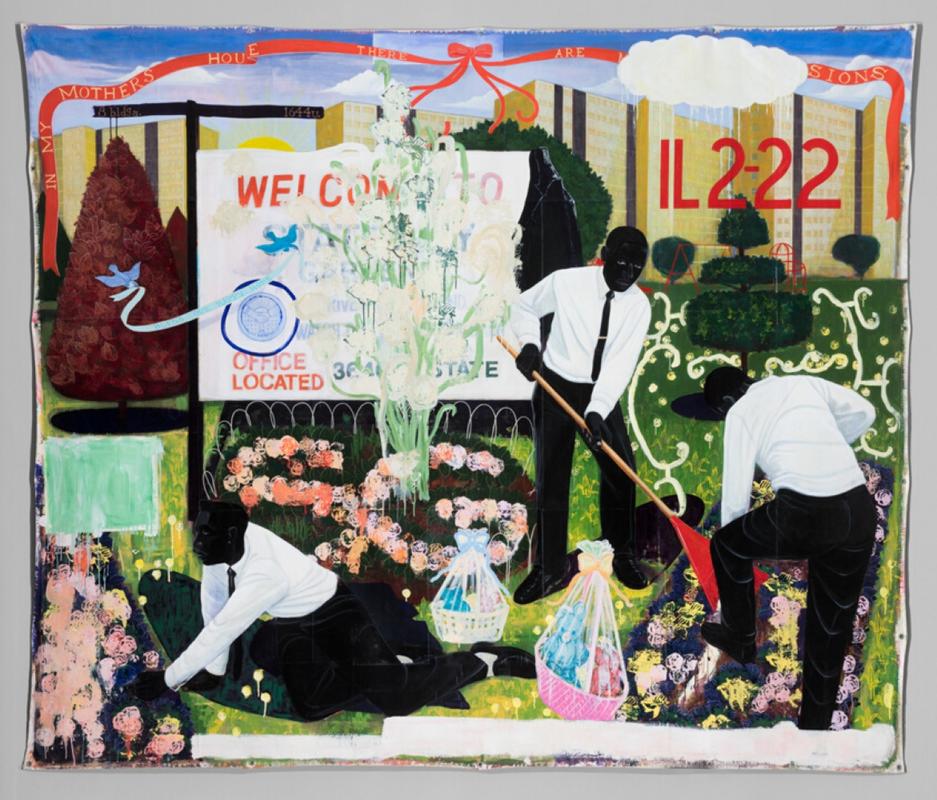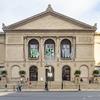More about Many Mansions

Contributor
Kerry James Marshall invites us to take a closer look at the complexities and contradictions of the American public housing system in Many Mansions.
“So I’m getting off the expressway everyday,” begins Kerry James Marshall in a discussion of his Garden Project series (of which both Many Mansions and his 1995 painting, Watts 1963, form a part) “and I see this sign, ‘Welcome to Wentworth Gardens.’ I look around Chicago and I see that there are three other housing projects called ‘gardens’—Stateway Gardens, Rockwell Gardens, Altgeld Gardens. They look like everything else but a garden...Was there a trend once to name housing projects as garden spots? Isn’t there an irony there?” Many Mansions is a reflection on this irony—on the disparity between the oddly pastoral “garden” in many housing projects’ names and the harsh realities of, you know, actually living there.
The “SG” spelled out in splotchy pink-and-white roses tells us this particular housing project is Stateway Gardens, a Chicago development demolished in 2001 due to building decay and escalating gang violence, both direct results from many years of municipal neglect. But Marshall’s Stateway Gardens isn’t merely a failure; Many Mansions’ three somber figures, dressed in their Sunday best, create beauty in the run-down projects by tending to a garden in the painting’s foreground. A fountain of graffiti-like white roses sprouts up from the flowerbeds to partially obscure a faded sign reading “Welcome to Stateway Gardens,” suggesting that the residents have, in a sense, “painted over” the false utopian promises offered when the projects were built with the real beauty of a culture that developed among the people who called Stateway Gardens home.
Built in 1958, Stateway Gardens was one of many urban housing projects constructed in the years after World War II with the intention of improving the living conditions of poor Americans living in city slums. Following the creation of the Federal Housing Administration in 1937, these slums were razed to the ground to make way for new high-rise buildings (as can be seen in the background of Many Mansions, propped up like a procession of flimsy cardboard cutouts) which, housing reformers hoped, would both literally and metaphorically raise residents up out of their destitute state. But the high-rise buildings only demarcated more clearly than ever before where the rest of the city ended and the projects began, resulting in the increased stigmatization and isolation of public housing residents. The new housing projects were also built in predominantly Black neighborhoods, thus deepening the racial segregation that was already very present in American cities. That the Dan Ryan expressway (which Marshall alludes to in his discussion of the series) was built in 1961—just a few years after the construction of Stateway Gardens—only served to isolate the community even further. From that point onward, commuters were able to sweep right past it, safely kept apart by their vehicles and yet never quite able to avoid seeing the shapes of the high-rises looming hugely beside them, a haunting reminder of the portion of Chicago’s population that had been tucked away and abandoned by the city that had promised to help them.
Many Mansions looks a bit like a dilapidated billboard, an aesthetic speaking to Marshall’s initial inspiration for his Garden Project series. There’s something distinctly Disney about the whole scene too—I can’t help but think of Cinderella when I look at the bluebirds of happiness floating down from the painting’s top-left corner with a baby-blue ribbon held between them. It’s possible that Marshall is deliberately referencing Disney here, as a company which sells a rose-tinted version of reality that doesn’t exist, thus furthering the painting’s general theme of contrasting idealized promises with the disappointing reality that was eventually delivered to public housing residents. At the top of the painting, on yet another ribbon (echoing the one carried between the bluebirds and those knotted around the Easter baskets at the mens’ feet), is the Bible’s phrase from John 14:2 that the painting’s title is referencing: “In my Father’s house there are many mansions.” Marshall, however, has switched out “father” here for “mother,” perhaps in an allusion to the majority of households in the projects being headed by single mothers.
As Marshall himself has made clear, Many Mansions is far more than just a critique of the failure of the American public housing system; it’s also a celebration of the often-overlooked beauties of a unique culture that’s sprouted up in the projects, in spite of adverse circumstances. Having grown up first in a low-rise project in Birmingham, Alabama, and later in the Nickerson Gardens development in Watts, Los Angeles, Marshall has many fond childhood memories of life in the projects. He’s stated before that the paintings in his Garden Project series “are meant to represent what is complicated about the projects,” explaining that, “We think of the projects as places of utter despair. All we hear of is the incredible poverty, abuse, violence, and misery that exists there. But [there] is also a great deal of joy, hopefulness, pleasure, and fun.” While I’m not sure how much fun it looks like these men are having gardening in their formalwear, they’re clearly determined to make their surroundings beautiful, with or without the help of the city.
Sources
- Hunt, D. Bradford. “What Went Wrong With Public Housing in Chicago? A History of the Robert Taylor Homes,” Journal of the Illinois State Historical Society 94, no. 1 (2001): 96-123.
- “Many Mansions.” The Art Institute of Chicago. Accessed July 29, 2020. https://www.artic.edu/artworks/137125/many-mansions.
- “Many Mansions by Kerry James Marshall, 1994.” The Art Institute of Chicago. Accessed July 29, 2020. https://www.artic.edu/assets/3539831c-9caf-9528-d717-f53a10fe968b.
- “Stateway Gardens.” Encyclopedia of Chicago. Accessed July 8, 2020. http://www.encyclopedia.chicagohistory.org/pages/2479.html.











